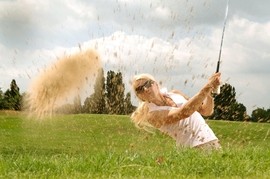Enjoying Golf and Preventing Injuries
 Golf is a global sport that people of all ages and abilities participate in, that typically involves long periods of low intensity exercise combined with short bursts of intense activity. Regardless of age and ability, golfers are at risk of injuries to the back, knees, shoulders, elbows, wrists and/or hands. But don’t let the fear of injury prevent you from enjoying this rewarding game – golf is a sport that can help you maintain a healthy lifestyle by helping you to gain and maintain flexibility. It also includes both aerobic and strengthening components as it involves a variety of physical activities including walking, lifting, and repeated upper extremity movement, so it’s a fantastic sport to participate in.
Golf is a global sport that people of all ages and abilities participate in, that typically involves long periods of low intensity exercise combined with short bursts of intense activity. Regardless of age and ability, golfers are at risk of injuries to the back, knees, shoulders, elbows, wrists and/or hands. But don’t let the fear of injury prevent you from enjoying this rewarding game – golf is a sport that can help you maintain a healthy lifestyle by helping you to gain and maintain flexibility. It also includes both aerobic and strengthening components as it involves a variety of physical activities including walking, lifting, and repeated upper extremity movement, so it’s a fantastic sport to participate in.
Tips for S.M.A.R.T. golfing to prevent injury:
(S) Stretch – before you tee off, give yourself about 10 minutes to warm up and get your blood flowing. A brisk walk, climbing a set of stairs, or a similar activity is a good warm up. Follow your warm up with dynamic stretching of your lower back, quadriceps, calves, shoulders, arms and hands and then you’ll be ready to tee off. If you start to feel tightness or stiffness during your round, take a few minutes to perform some more stretching. After you’re finished, cool down with another set of static stretches for all of the muscle groups that you used. Keep in mind that when stretching, your movements should be controlled and slow so you feel a slight stretch of the muscle, not pain. Once you feel a mild stretch, hold it for about 15 to 20 seconds. Repeat each stretch, three times, on both sides of your body.
(M) Move – start moving and keep moving throughout the year, not just during golf season. Walk the course if you can to improve your cardiovascular health and enhance your fitness level. Before hitting the ball, take a practice swing to warm up for that particular stroke, which will not only improve your technique, but will also improve your mobility. Also, don’t put the clubs away when the snow falls, there are numerous indoor facilities where you can play year-round.
(A) Add It Up – aim for 60 minutes of physical activity every day, all year. This can be broken down into 10-minute segments throughout the day. If you’re new to golf or haven’t been out in a while, pace yourself – start with 9 holes, instead of 18, and plan your golf games so that they’re spread out through the week or month, to help you build up your strength and mobility. However, even if you’re not playing a round of golf, make stretching a part of your daily routine to maintain your range of motion and flexibility.
(R) Reduce Strain – make sure you’re using the right equipment for your size and skill level. Ensure that you carry your bag over both shoulders or alternate which side you carry it on. If you have a wheel golf cart, push it as opposed to pulling it. When lifting your bag, keep it close to your body and avoid twisting, while keeping your back straight and bending with your knees. Hold your clubs with a comfortable, loose grip to avoid straining your forearms and hands. Throughout your round, make sure you stay hydrated and take breaks as needed.
(T) Talk to a physiotherapist – they can help to improve your game and minimize your risk of injury.
If you’re a golfer and want to enjoy the game fully and prevent injury, you may benefit from physiotherapy. A physiotherapist will assess your muscles, joints, and nervous system, look at how you move, and explore not only your golf techniques, but also your work and leisure activities to determine possible causes of your pain. Individual treatment will often entail hands-on work to the body structures at fault as well as education and rehabilitative exercise to keep you pain and injury free.
Undergoing a comprehensive evaluation by physiotherapists at North Hill Physiotherapy is one of the best ways to gain an understanding of how you can enhance your golf game. After the assessment, our physiotherapists will create a program that is specific to your needs, and can help improve your golf game and minimize your risk of injury.
References
1. Evans K, Tuttle N. Improving performance in golf: Current research and implications from a clinical perspective. Brazilian Journal of Physical Therapy. 2015;19(5):381–389. doi:10.1590/bjpt-rbf.2014.0122.
2. Meira EP, Brumitt J. Minimizing injuries and enhancing performance in golf through training programs. Sports Health: A Multidisciplinary Approach. May 2010. doi:10.1177/1941738110365129.
3. Golf injury Prevention-OrthoInfo. http://orthoinfo.aaos.org/topic.cfm?topic=a00137. Accessed February 13, 2017.
4. S.M.A.R.T. Golfing. Canadian Physiotherapy Association. http://www.physiotherapyns.ca/images/uploads/Golfing(1).pdf. Accessed February 13, 2017.
